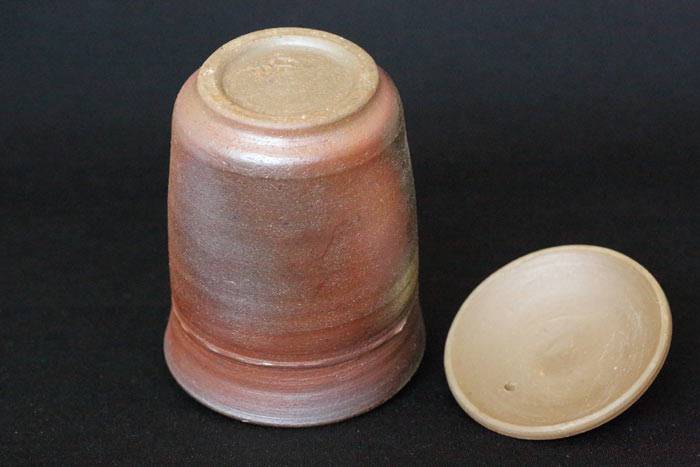| Brand: Fumiharu Kino |
| Available: 0 |
| Brand: Fumiharu Kino |
| Available: 0 |

Fumiharu Kino, Japanese Bizenyaki tall type houhin, wood-fired non-hanlde teapot















Made by Fumiharu Kino
Made in Japan
Size:Height 10.5cm * Width 9.3cm * Depth 8.6cm
Material:Pottery
Capacity:(Maximum)250ml
Package: Paper Box
Shipping Cost (It might differ from the actual EMS shipping rate)
Asia District (Taiwan, Hong Kong, Singapore, Malaysia, Thailand, Vietnam, Philippines, Macau, China, etc.) - JPY 1720
America District(USA, Canada, Mexico, Costa Rica, etc) - JPY 2400
Oceanea District(Australia, New Zealand, New Caledonia, Fiji, Papua New Guinia, etc) - JPY 2400
Middle East District(Turkey, Saudi Arabia, UAE, Oman, Qatar, Iran, Iraq, Kuwait Bahrain, Israel, etc )- JPY 2400
Europe District(France, England, Germany, Italy, Spain, Switzerland, Sweden, Denmark, Finland, Belguim, Poland, Russia, etc) - JPY 2600
Shipping method
We use EMS(Express Mail Service). After we ship the product, it will take 3-10days to arrive at your place. You can track the parcel.
Purchaser of the product must read the below condition carefully.
Return/exchange and refund
We will not accept return/exchange of the product unless the products we sold have any damages or we shipped the wrong item. If we accept the return/exchange, the products must be complete and without any signs of having been used or damaged.
The product is carefully examined before shipping. However, in case there is any damage in the product, you should check the product within 7 days and report to us after receiving it (the days are calculated fromt the proven date of delivery). Otherwise, we will not be responsible for the damage, so please check the quantity, apparent condition, etc., when the product arrives.
The color of the product you will receive might look slightly different from the pictures you see in this web page. This is because depending on the amount of light when the picture was taken, the color in each picture might look different. Please understand, we will not accept return or make refund because of the above reasons.
We will not be responsible for any of the customs clearance and customs duty/tariff payment.
Fumiharu Kino
The beauty of Bizen-yaki – Bizen ware – lies in the essence of clay itself: Over the course of two long weeks in a wood-fired kiln, unique discolorations and patterns of patina, known as yōhen, appear on the surface of each piece without any help from glaze.
One such yōhen, known as sangiri, is Fumiharu Kino’s calling card. These pieces exhibit brilliant spots of white and yellow, produced when charcoal is added to the kiln.
“I might be about the only Bizen-ware artisan to make charcoal myself,” Kino says. How and whether the sangiri effect appears on each work depends on how much charcoal reacts with each piece, making the pieces that do bear it richly expressive. Kino has also altered his kiln to encourage the sangiri effect to appear more often, installing more slots where charcoal can be inserted.
Kino was born in 1951 to a happy home near the Imbe section of Bizen, Okayama – the home of Bizen-ware. He toiled as an ordinary office-worker for six years after graduating high school. But at the age of 24, he began working at the Bisyugama workshop under Tōshū Yamamoto, a relative of his wife who would later be named a Living National Treasure of Japan. Kino studied under Yamamoto – and then his son Yuichi Yamamoto, later named an important intangible cultural property of Okayama Prefecture – for 20 years.
He learned well the lessons they had to teach. Tōshū Yamamoto was renowned for his use of the pottery wheel to create teaware with elegant, refined silhouettes. “He was very strict, and obsessed with the beauty of a piece’s shape,” Kino recalls. “He would not compromise a bit.”
 Yuko Sugama
Yuko Sugama
 Takashi Baba
Takashi Baba
 Kazuya Furutani
Kazuya Furutani
 Noriyuki Furutani
Noriyuki Furutani
 Masayuki Uraguchi
Masayuki Uraguchi
 Yuichi Hirano
Yuichi Hirano
 Etsuko Tange
Etsuko Tange
 Shikamaru Takeshita
Shikamaru Takeshita
 Tomoyuki Ohiwa
Tomoyuki Ohiwa
 Shinsaku Hamada
Shinsaku Hamada
 Tomoo Hamada
Tomoo Hamada
 Ayano HItotsumatsu
Ayano HItotsumatsu
 Tomoyuki Matsui
Tomoyuki Matsui
 Hiromi Yamamoto
Hiromi Yamamoto
 Jozan Yamada the 3rd
Jozan Yamada the 3rd
 Jozan Yamada the 4th
Jozan Yamada the 4th
 So Yamada
So Yamada
 Setsudo
Setsudo
 Setsugetsu Yoshikawa
Setsugetsu Yoshikawa
 Seiji Itoh (Jinshu)
Seiji Itoh (Jinshu)
 Shuroku Harada
Shuroku Harada
 Teruyuki Isobe
Teruyuki Isobe
 Hiroshi Koie
Hiroshi Koie
 Munehiko Maruta
Munehiko Maruta
 Dohei Fujinoki
Dohei Fujinoki
 Jinpachi Ogawa
Jinpachi Ogawa
 Ken Matsuzaki
Ken Matsuzaki
 Yutaro Yamada
Yutaro Yamada
 Yusuke Wakasa
Yusuke Wakasa
 Masahiro Takehana
Masahiro Takehana
 Sho Fujita
Sho Fujita
 Tokuta Fujita
Tokuta Fujita
 Takeshi Shimizu
Takeshi Shimizu
 Emi Masuda
Emi Masuda
 Mayuki Kato
Mayuki Kato
 Kenji Kojima
Kenji Kojima
 Takashi Tanimoto
Takashi Tanimoto
 Yoshinobu Morimoto
Yoshinobu Morimoto
 Chuza Ohnishi
Chuza Ohnishi
 Sho Kumamoto
Sho Kumamoto
 Yohei Konishi
Yohei Konishi
 Munenori
Munenori
 Toju
Toju
 Teruhiko Omori
Teruhiko Omori
 Hiroaki Omori
Hiroaki Omori
 Fumiharu Kino
Fumiharu Kino
 Mitsuhiro Chiba
Mitsuhiro Chiba
 Motozo
Motozo
 Shuho
Shuho
 Shun-en
Shun-en
 Takeshi Sano, Yoko Sano
Takeshi Sano, Yoko Sano
 Tayama Ironware Studio (Kazuyasu Tayama)
Tayama Ironware Studio (Kazuyasu Tayama)